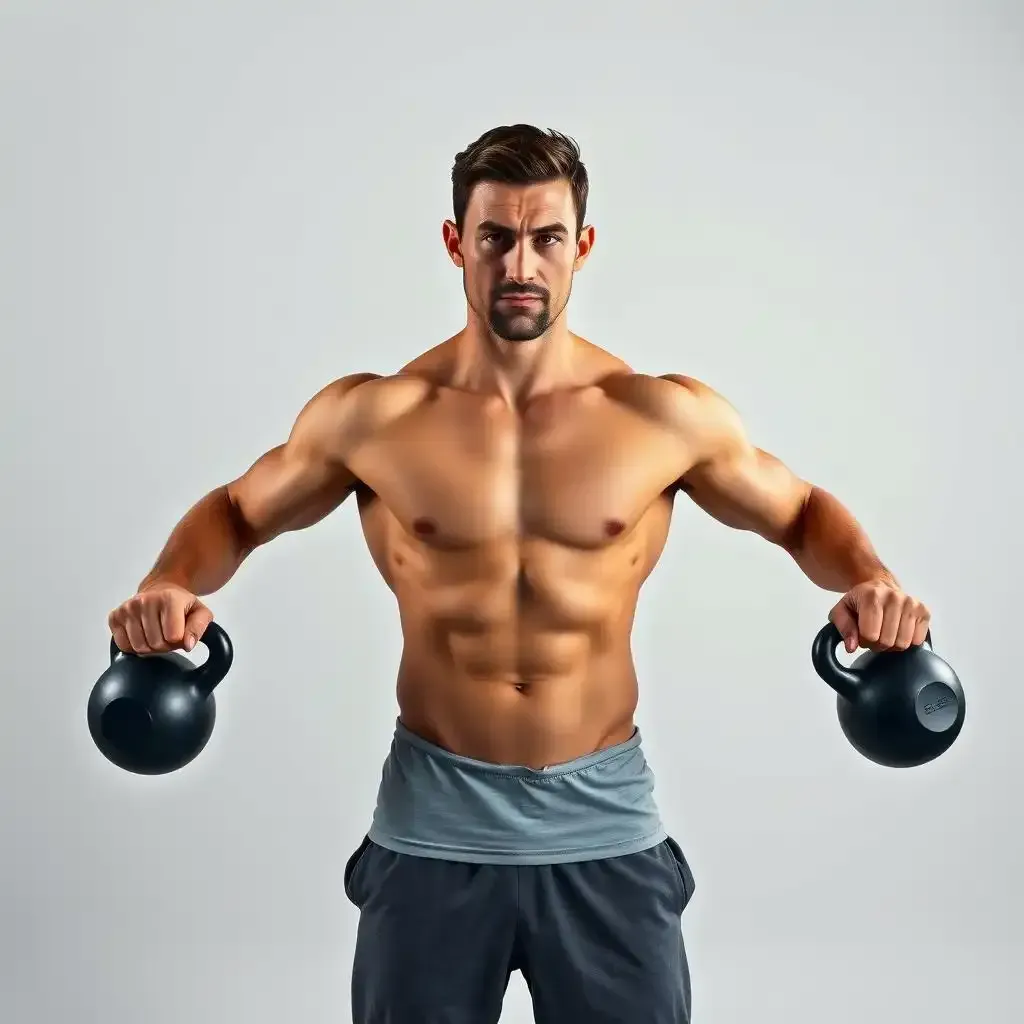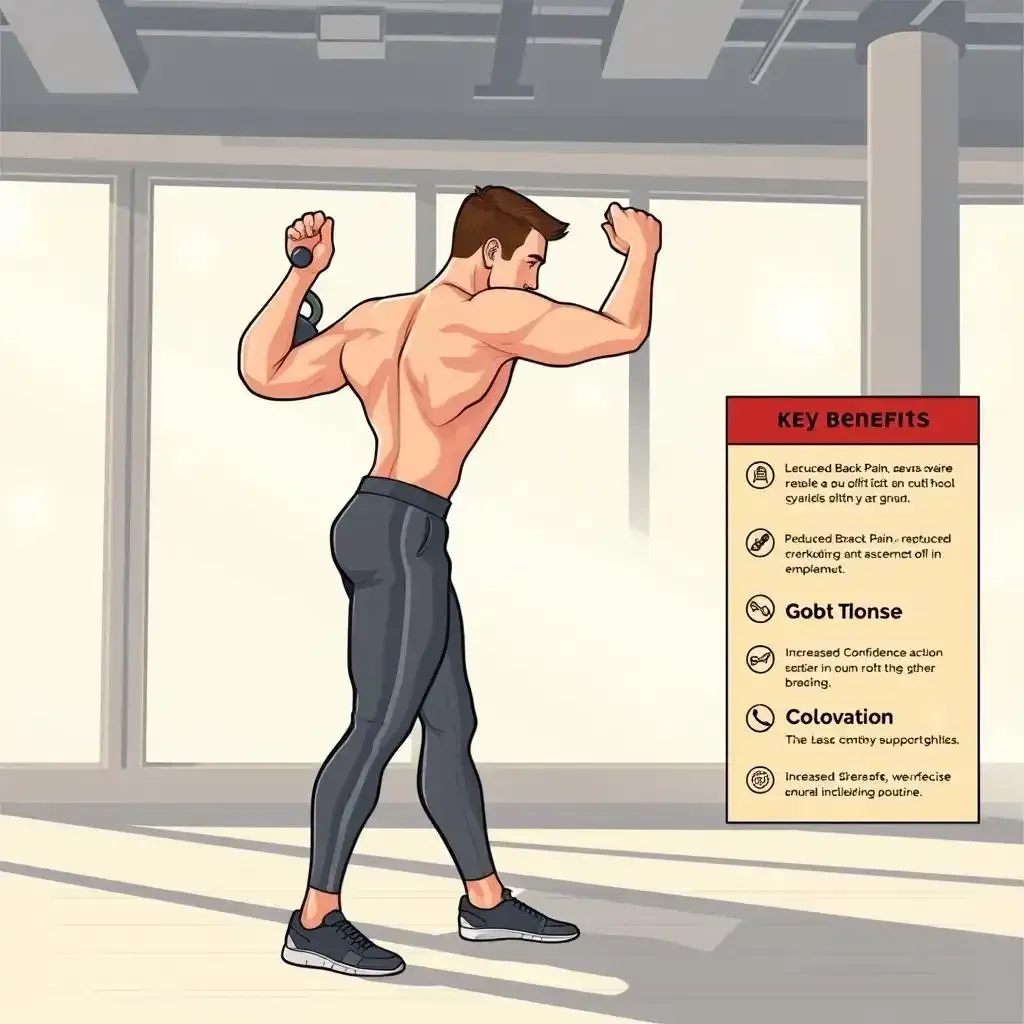Table of Contents
Are you tired of slouching and wanting to improve your posture? You're not alone. Many of us spend hours each day hunched over desks or smartphones, leading to back pain and poor posture. But what if you could strengthen your back and improve your posture with just a few simple exercises? Enter kettlebell posture routines. On kettlebellworkout.homes, we'll explore the best kettlebell posture routines to help you stand taller and feel stronger. From understanding the benefits of kettlebell posture routines to creating a customized routine for your needs, we'll cover it all.
Kettlebell Posture Routines for a Stronger Back

Kettlebell Posture Routines For A Stronger Back
Why Kettlebells? A Powerful Partnership
Hey there, fellow writer! So you're diving into kettlebell posture routines? Awesome! I've been obsessed with kettlebells for ages. They're not just about bulging biceps; they're a total-body game-changer. Think of them as tiny, iron magic wands that sculpt your muscles *and* improve your posture. Seriously, I used to slump like a wilting flower, but since I started using kettlebells, I feel like I've grown a couple of inches taller – and way more confident! It's like they're secretly training your body to remember how to stand up straight. Want to learn more about building a strong foundation? Check out our guide to kettlebell basics.
- Improved core strength: Kettlebell exercises, like swings and squats, make your core muscles stronger.
- Better balance: Using kettlebells helps you balance better and improves your overall body awareness.
- Increased flexibility: Some kettlebell movements help you stretch your muscles and become more flexible.
Mastering the Moves: Kettlebell Exercises for Posture
Now, let’s talk specifics. Forget those boring back exercises! Kettlebell swings are your new best friend. They're like a full-body hug for your posture, working your back, core, and legs all at once. Imagine a graceful pendulum, that's the kind of fluid movement you want to achieve. Another great one is the Turkish Get-Up. It's a total-body movement that challenges your stability and coordination. It's not easy at first, but once you get the hang of it, you'll feel like a superhero! For simple, effective exercises for beginners, check out our beginner kettlebell exercises guide.
Exercise | Focus | Benefits |
|---|---|---|
Kettlebell Swings | Hips, back, core | Strengthens posterior chain, improves posture |
Turkish Get-Up | Full body | Improves stability, coordination, and core strength |
Goblet Squats | Legs, core | Strengthens legs, improves hip mobility |
Listen to Your Body: Form Over Force
Okay, here’s the super-important part: form is everything! Don't try to lift heavier weights than you can handle. Start with lighter kettlebells and focus on perfecting your technique. Think of it like learning to ride a bike – you wouldn't try to do a wheelie before you can even pedal straight, right? Proper form prevents injuries and maximizes results. If you're unsure about your form, consider working with a qualified trainer. They can help you master the moves and ensure you're getting the most out of your kettlebell workouts. Plus, a little professional guidance can really boost your confidence and motivation. For more tips on safe kettlebell practices, see our post on kettlebell safety tips.
Understanding the Benefits of Kettlebell Posture Routines

Understanding The Benefits Of Kettlebell Posture Routines
Why Kettlebells Are Awesome for Your Posture
Okay, let's be honest, most of us spend way too much time hunched over screens. It's like we're slowly turning into question marks! But here's the good news: kettlebells can totally rescue your posture. Think of them as tiny personal trainers, constantly whispering, "Stand up straight!" They don't just build muscle; they build *awareness*. Suddenly, you're paying attention to your body's alignment in a way you never did before. You'll feel more confident and powerful, too! It's like discovering a secret superpower – a straight back! For more basic kettlebell moves, check out our guide on .
- Stronger core: Kettlebell exercises like swings and squats make your core muscles super strong. This is like building a solid foundation for your whole body, keeping you upright and balanced.
- Improved balance: Using kettlebells improves your balance and body awareness. It's like training your body to be a super-stable tree, even when things get a little wobbly.
- Increased flexibility: Certain kettlebell movements help stretch out tight muscles, making you more flexible and less likely to slouch.
Kettlebell Posture: More Than Just a Pretty Back
It's not just about looking good; it's about *feeling* good. Good posture means less back pain, more energy, and even better breathing. Imagine yourself standing tall and confident, ready to take on the world! That's the ability of kettlebell posture routines. You're not just fixing a problem; you're building a better, stronger you. Plus, it's way more fun than those boring old stretching exercises, isn't it? If you're just getting started, check out our for some easy-to-follow routines.
Benefit | How Kettlebells Help | Real-World Example |
|---|---|---|
Reduced Back Pain | Strengthening core muscles provides support | Less pain when sitting or standing for long periods |
Improved Breathing | Better posture allows for fuller lung capacity | More energy and stamina throughout the day |
Increased Confidence | Good posture projects strength and self-assurance | Feeling more comfortable and at ease in social situations |
Incorporating Kettlebell Posture Routines into Your Workout

Incorporating Kettlebell Posture Routines Into Your Workout
Okay, so you're ready to add some kettlebell magic to your workout routine? Awesome! But don't just throw kettlebells into your current workout willy-nilly. Think of it like adding a new spice to your favorite dish – you gotta do it right to make it amazing, not a disaster! Start slow and steady. Don't try to become a kettlebell ninja overnight. Remember when you were learning to ride a bike? You didn't start with jumps and wheelies, right? You started with baby steps, and that’s exactly what I recommend here. Begin by adding one or two kettlebell exercises to your existing routine, maybe twice a week. I found that starting with kettlebell swings and goblet squats was a great way to build a base level of strength and coordination. For more ideas on simple and effective routines, check out our beginner kettlebell workouts.
- Start with 1-2 exercises, 2 times a week.
- Focus on proper form over heavy weights.
- Gradually increase reps, sets, and weight as you get stronger.
Listen to your body. Pain is your body's way of saying "Whoa, hold up!" If something hurts, stop and rest. Don't push yourself too hard, especially at first. Think of your body as a finely tuned machine; you want to maintain it, not break it! It's better to have a few consistent, well-executed workouts than a bunch of half-hearted attempts that lead to injury. Remember, consistency is key! Think of it like watering a plant - small, regular amounts are much more effective than infrequent, large amounts. For more tips on getting the most out of your workouts, check out our guide on kettlebell workout tips.
Day | Exercise | Sets | Reps |
|---|---|---|---|
Monday | Kettlebell Swings | 3 | 10-12 |
Wednesday | Goblet Squats | 3 | 10-12 |
Friday | Rest or light cardio | - | - |
As you get stronger, you can gradually increase the number of exercises, sets, and reps. You can also start incorporating more advanced kettlebell moves, such as the Turkish Get-Up. But again, remember to prioritize proper form. It's much better to do fewer reps with perfect form than many reps with sloppy form. Remember, you're building a foundation for a strong, healthy back, not just trying to impress your gym buddies! For exercises that really target your posture, check out our posture-focused kettlebell exercises.
One more thing: don't forget to warm up before each workout and cool down afterward. A proper warm-up prepares your muscles for exercise, reducing the risk of injury. A cool-down helps your body recover and prevents stiffness. Think of it like prepping your car before a long drive – you wouldn't just jump in and start driving, would you? For some great warm-up and cool-down ideas, check out our warm-up exercises and cool-down exercises guides.
- Warm-up before each workout
- Cool-down after each workout
- Listen to your body and rest when needed
Creating a Customized Kettlebell Posture Routine for Your Needs

Creating A Customized Kettlebell Posture Routine For Your Needs
Now, let’s talk about how to create a personalized kettlebell posture routine that fits your unique needs. Just like a tailor-made suit, a customized routine can make a world of difference. Start by assessing your posture. Stand in front of a mirror and check if your shoulders are hunched, your back is curved, or your head is forward. These are common issues that kettlebell exercises can help address.
Once you know your problem areas, choose exercises that target them. For example, if you have tight hip flexors, focus on kettlebell swings and hip mobility exercises. If your upper back is weak, prioritize exercises like the Turkish Get-Up and kettlebell rows. Remember, it’s all about balance. Just like a seesaw, your body needs to be balanced to function optimally.
- Assess your posture in front of a mirror
- Identify problem areas like hunched shoulders or a curved back
- Choose exercises that target these specific issues
Don’t forget to mix things up. Just like you wouldn’t wear the same outfit every day, you shouldn’t do the same exercises all the time. Vary your routine to keep your muscles engaged and prevent plateaus. For example, you can switch between high-rep days and heavy lifting days. This keeps your workouts fresh and challenging.
And here’s a little secret: consistency is key. It’s better to do a few minutes of kettlebell exercises every day than to do a long, intense session once a week. Think of it like watering a plant. Small, regular doses are more effective than sporadic, heavy watering. For more tips on building a consistent routine, check out our .
Day | Exercise | Sets | Reps |
|---|---|---|---|
Monday | Kettlebell Swings | 3 | 10-12 |
Wednesday | Turkish Get-Up | 3 | 5-7 |
Friday | Goblet Squats | 3 | 10-12 |
Finally, listen to your body. If something doesn’t feel right, don’t push through the pain. Adjust your form, use a lighter kettlebell, or take a break. Your body will thank you. And don’t forget to celebrate your progress, no matter how small. Each step you take is a step towards a stronger, more confident you.
Final Thought
Improving your posture takes time and practice, but with the right kettlebell posture routines, you can strengthen your back and stand taller. Remember to start slow, listen to your body, and be consistent. With kettlebell posture routines, you can say goodbye to back pain and hello to a stronger, healthier you. For more workout tips and kettlebell exercises, visit kettlebellworkout.homes and start your fitness process today.